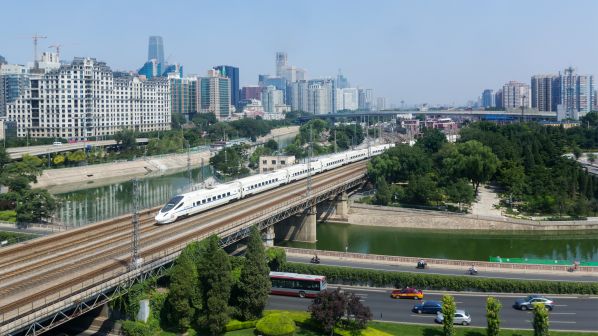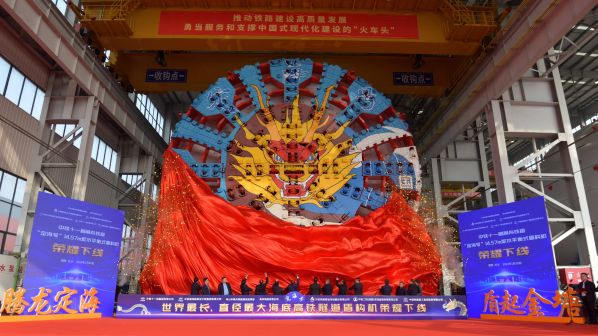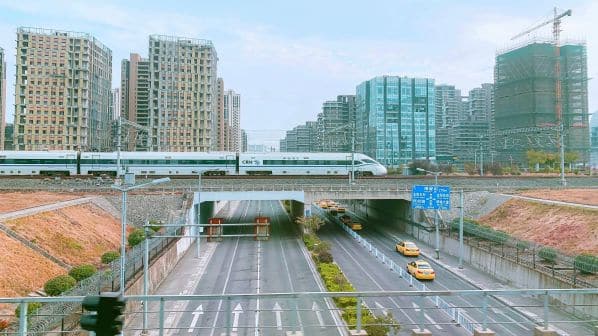DESPITE slower than expected economic growth, with the rise in GDP forecast to dip below 5% this year, and the long-lasting effects of Covid-19, China’s programme to develop a comprehensive nationwide network of high-speed lines, connecting all major population centres, with trains designed for ever-higher speeds, continues apace, with over 2100 route-km completed on eight projects in 2023 alone.
In December the 208km Jinan - Puyang section of the 407km Jinan - Zhengzhou (Jizheng) high-speed line opened to traffic, marking the completion of the Jizheng high-speed project, which started construction in June 2020. The line serves Jinan and Liaocheng in Shandong province, and Puyang, Anyang and Xinxiang in Henan province. The fastest train between Jinan West and Zhengzhou East takes 1h 43min, a saving of 1h 29min. China Railway (CR) plans to operate 61 trains per day on the new line which interconnects with several existing lines such as the Beijing - Shanghai and the Beijing - Kowloon high-speed lines.
The 288km line between Huangshan and Nanchang also opened in December, completing the 560km high-speed line between Hangzhou in Zhejiang province and Nanchang in Jiangxi province. The newly-constructed section serves Huangshan North, Yixian East, Qimen South, Fuliang East, Jingdezhen North, Leping North, Poyang, Yugan, Jinxian North and Nanchang East.
The project has involved increasing station capacity at both Huangshan North and Jingdezhen North. Up to 32 trains a day are running during the initial phase of operations, with the fastest journey time between Huangshan and Nanchang now 1h 45min. The new line between Hangzhou and Nanchang serves many major tourist destinations, connecting the provinces of Zhejiang, Anhui and Jiangxi.
Tourism
Another high-speed route that opened in December, and is also expected to stimulate tourism, is the 92km line between Longyan and Wuping in the eastern province of Fujian, designed for a service speed of 250km/h.
This line opened at the same time as the 162km Shantou - Shanwei high-speed line serving the Greater Bay Area in eastern Guangdong province. Journey times from Shantou to Shanwei, Guangzhou and Shenzhen have been reduced to 36 minutes, 1h 53min and 1h 49min respectively.
Construction of the line presented many challenges due to the high humidity and salt levels of the coastal climate. Structures include a major bridge over the Aojiang River and the Huilai Tunnel, while the final 20km section, including a marine tunnel beneath Shantou Bay, remains under construction.
CR says it expects to complete prototype production and testing of its CR450 high-speed train this year.
And in the southern part of Sichuan province, a 261km high-speed line also opened in December linking Chengdu with Zigong and Yibin, cutting the Chengdu - Zigong journey time from several hours by road to 51 minutes by rail. The journey time from Chengdu to Yibin is 1h 13min. Taking the new line thorough the mountains and deep valleys of Sichuan required the construction of 231 bridges and 29 tunnels, and its completion is expected to boost tourism and economic development, improving connections with Chengdu, the provincial capital.
The prospects for high-speed rail construction over the next five years are impressive, with a total of 35 high-speed lines extending over nearly 8600 route-km expected to open by 2028. Around 110 new rail projects, including high-speed lines, are underway in 2024.
China’s original objective for a high-speed rail network was a four-by-four grid of rail corridors, four running roughly north-south and four running east-west. When that grid was largely in place by 2016, attention focused on enlarging it to an eight by eight grid (in China the number eight is widely perceived as being fortuitous) and if construction of new lines continues at current levels it is likely that this will be achieved by the end of this decade.

China’s 14th Five-Year Plan (2021-25) aims for high-speed rail lines to connect 95% of all cities with at least 500,000 inhabitants by 2025, with a total of 50,000km of high-speed lines operational as part of a total national rail network of 165,000km. State planners have started preliminary work on the 15th Five-Year Plan (2026-30) and this is expected to maintain a focus on developing the expanding high-speed rail network and developing faster trains.
CR says it expects to complete prototype production and testing of its CR450 high-speed train this year. It will operate in service at up to 400km/h, but will be tested at around 450km/h, with a trial run last year reaching 453km/h. The first production trains are expected to enter passenger service in 2025. The CR450 could bring substantial reductions in journey times. The 1300km between Beijing and Shanghai, for example, could be covered in as little as 2h 30min, down from 4 hours at present.
This year had barely begun when construction started on a high-speed line from Jinan, west of Qufu, southeast to Zaozhuang in Shandong province on January 2. The 268km line includes 10 stations, two of which are interchanges with the Beijing - Shanghai high-speed line, which the new route runs parallel to along parts of its length. The Jinan - Zaozhuang high-speed line, which is expected to be completed in 2027, is one of eight north-south regional high-speed trunk routes (together with six east-west) listed in Shandong province’s Three-dimensional Transport Network Planning Outline 2023-2035 that was released in November last year. Under the plan, Shandong province will have 6500km of high-speed lines by 2035, including 15 regional lines.
New lines aplenty
New high-speed lines expected to be completed this year include a 163km link between Shanghai, Suzhou in Jiangsu province and Huzhou in Zhejiang province. Construction started in 2020 and includes five new stations, with existing stations at either end. It will link key cities in the Yangtze River delta. In Shanghai the new line will provide an interchange with four metro lines.
Also due to open this year is a 277km line between Hangzhou, Yiwu and Wenzhou, serving six new stations and two existing ones.
Other new high-speed lines scheduled to be completed over the next five years include a 400km connection between Weifang and Suqian, linking the south central area of Shandong province with the north of Jiangsu province via 10 intermediate stations.
Of a similar length is the link between Guangzhou and Zhanjiang, via Foshan, Zhaoqing, Yangjiang and Maoming, that will serve nine new stations, as well as three existing ones, and will interconnect with a number of high-speed and conventional main lines.
Construction started in 2018 on the 270km Chongqing - Qianjiang section of the 810km Chongqing - Changsha route that will serve the districts of Yuzhong, Nan’an, Banan, Nanchuan, Wulong and Pengshui County. The line will serve six new stations, with two existing stations reconstructed to serve the new route, that will also connect with the Qianzhang - Changzhou high-speed line.
Economists suggest that China will significantly increase investment in transport infrastructure this year, pointing to a newly-issued Yuan 1 trillion ($US 139bn) treasury bond for the sector. High-speed projects are likely to benefit from this influx.
At the end of 2023, according to China Railway, the country’s rail network extended over a total of 159,000 km, including 45,000km of high-speed lines, up considerably from the 31,000km in operation in late 2019. Approximately 3600km of conventional lines and nearly 2800km of high-speed lines, spread across 34 projects, were completed during the year.
The rail sector invested a total of Yuan 764.5bn ($US 106.8bn) in fixed assets during 2023, a year-on-year increase of 7.5%
Rail passenger journeys reached 3.68 billion in 2023, a significant increase on the 1.7 billion reported in 2022, with 3.91 billion tonnes of freight carried, the highest ever totals recorded. On average 10 million passenger-journeys were made every day.
Despite the Russia-Ukraine conflict, a total of 17,000 container trains ran between China and Europe in 2023, carrying over 1.9 million TEU. The number of trains operated grew 6% on those operated in 2022, while container throughput rose by 18%.
Record-breaking tunnel boring machine built for new high-speed line
With 2024 barely underway, the intent to move firmly forward on Chinese high-speed rail projects was underscored by the presentation on January 16 of the completed tunnel boring machine (TBM) that will build the 16.2km Jintang marine tunnel, a key section of the 77km Ningbo - Zhoushan line in Zhejiang province in eastern China.
Not only will the Jintang tunnel be China’s first and longest marine tunnel, with a maximum depth of 76m, the TBM itself has already entered the record books as the world’s longest and widest machine. When fully operational it will extend to a length of 11km and is 14.6m wide, weighing in at 4350 tonnes, some 700% heavier than standard TBMs.

The machine, named Dinghaihao, was built jointly by CRCG’s 11th Bureau and China Railway Construction Heavy Industry in Changsa, in south central China, and will be dismantled and transported 1000km to the worksite.
The oversize dimensions of the TBM are necessary to overcome the complex geology and busy maritime traffic above. Around 90% of the Ningbo - Zhoushan high-speed line is either elevated on 36 bridges or underground in 17 tunnels. The new line is due to open in 2026.
CRCG says its engineers have employed innovative technical advances in the new TBM, including advanced geological forecasting, saturated pressure tool changing, TBM tail synchronous dual liquid slurry, a double-layer shell, segment floating monitoring and wall back grouting, which should ensure safe, green, efficient and high-quality tunnel construction.
One hour radius
The Ningbo - Zhoushan line will offer a journey time of 26 minutes when completed. This compares with the current journey time of 90 minutes and will achieve Zhejiang province’s goal of a one-hour radius journey time by high-speed rail for all major centres in the province.
It will also help to accelerate integration of Zhoushan and Ningbo into China’s national Belt and Road economic development strategy, as well as the Yangtze River Economic Belt.

